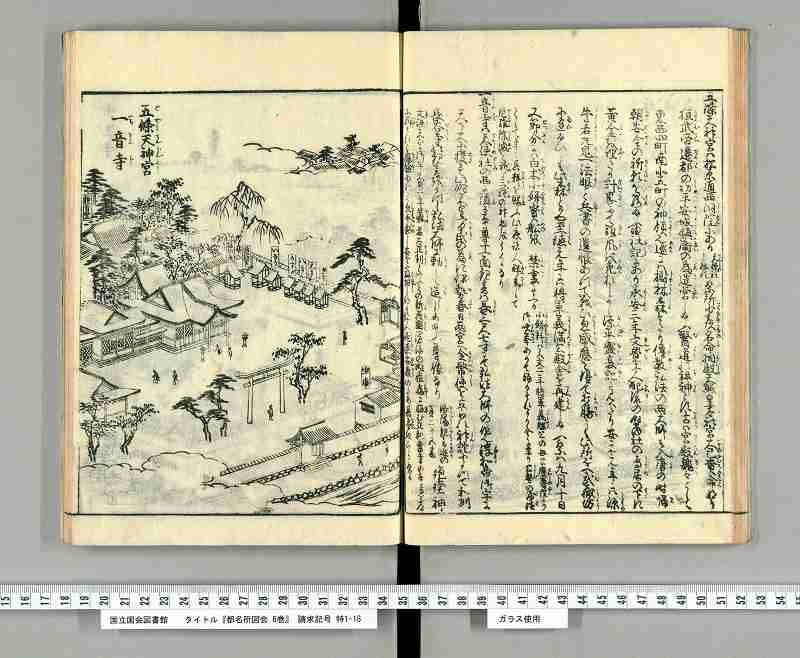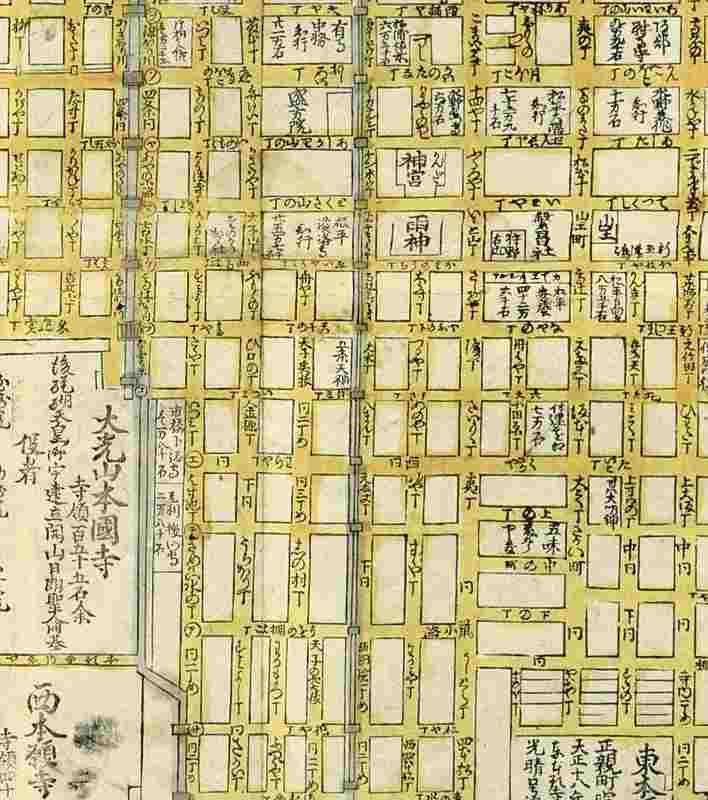
A page from a Kyoto guidebook for tourists published in 1786 shows Gojo Tenjinsha shrine.
15:07 JST, April 30, 2022
The story of a well leading to the world of the afterlife, as described in this column on March 27, is one of the many myths dating from the Heian period (late 8th to late 12th centuries). In those days, aristocrats and commoners alike were all afraid of falling down into another world through the well. As time passed, society started to grow out of such superstitions, and by the end of the Sengoku (warring states) period in the 15th and 16th centuries, the realms of Buddha and the gods were held in considerably less awe.
And yet, it was just after the Sengoku period that one area of Kyoto ended up with the name Tenshi-tsukinuke, which literally translates as “angel piercing.”
In contemporary Japan, the word “tenshi” predominantly refers to an angel in Christianity. When I see the name of this Kyoto town, therefore, I get the odd sense of seeing something pierce the body of an angel.
Yet tenshi in this district name refers not to a Christian angel but to a deity called Sukunahikona no mikoto, who is enshrined in the Gojo Tenjinsha shrine near the town. This legendary god purportedly came down to earth on a divinely assigned errand and is therefore called a tenshi. The shrine built in the early Heian period is known by names including Tenshisha (Angel shrine).
However, Sukunahikona no mikoto is not alone there. Many Japanese shrines honor multiple deities. In the case of Gojo Tenjinsha shrine, the enshrined deities also include famous Heian period politician and poet Sugawara no Michizane, who was posthumously deified.

Gojo Tenjinsha shrine is seen surrounded by apartment blocks in Shimogyo Ward, Kyoto.
“Tenjin” — which sounds similar to “tenshi” — is the name of Michizane as a god, while Gojo is simply the name of the street in front of the shrine.
During the Sengoku period, Christianity came to Japan, and the idea of an angel was expressed in Japanese as “tenshi,” which complicated things.
Now, what really “pierced” through tenshi was a road.
After the Sengoku period, Toyotomi Hideyoshi (1537-1598), who brought the era to an end, became the new ruler of Japan and embarked on reforming the city of Kyoto. One of the steps in his renovation plan was to make new roads.
In Kyoto, as it had previously existed, roads were built in a grid pattern. Each block of the grid was rather large, measuring 120 meters on a side. This was no problem when aristocrats or temples used up a whole block for their estates or precincts. When commoners built small houses fronting the roads, however, the middle section of the block became a dead space cut off from access to the street.
Therefore, Hideyoshi had new roads built to slice through the center of each block, either north-south or east-west.

Detail of a map of Kyoto published in 1686. The shrine name “Gojo Tenjin” is seen on the left side of the vertical road in the center, and the area name Tenshi-tsukinuke is seen on the road on the left of the central road.
New districts then formed along both sides of the new roads, and the names for such areas included the word “tsukinuke” (piercing or penetrating). Some parts of Kyoto are still called by such names. Kamigyo Ward, for example, has Oharaguchi-tsukinuke, Kinoshita-tsukinuke, Shinnyodo-tsukinuke and Yashiro-tsukinuke, while Nakagyo Ward has Echigo-tsukinuke and Niomon-tsukinuke.
Additionally, some places are simply called Tsukinuke. There are three such areas in Kamigyo Ward and two in Nakagyo Ward.
The district of Tenshi-tsukinuke is in Shimogyo Ward. The large, old-style block where Gojo Tenjinsha shrine is located had been mostly occupied by the shrine and its premises, with hardly any dead space. But a road was cut through the shrine precinct anyway.
It was a secular road passing through a “divine” realm. People moved in and started living along it. The shrine, deprived of much of its land, began to decline.
By the way, even Kyoto residents are mostly oblivious to the history of Tenshi-tsukinuke. A friend of mine, xylophone player Mutsumi Tsuzaki, lives in Tenshi-tsukinuke. She told me of an incident that happened when she enrolled at a high school that was not near her house. She submitted some paperwork with her address on it and ended up being scolded by the teacher, who thought she was joking.
"Society" POPULAR ARTICLE
-

M4.9 Earthquake Hits Tokyo, Neighboring Prefectures
-

M7.5 Earthquake Hits Northern Japan; Tsunami Waves Observed in Hokkaido, Aomori and Iwate Prefectures
-

Israeli Tourists Refused Accommodation at Hotel in Japan’s Nagano Pref., Prompting Protest by Israeli Embassy and Probe by Prefecture
-

Tsukiji Market Urges Tourists to Avoid Visiting in Year-End
-

M5.7 Earthquake Hits Japan’s Kumamoto Pref., Measuring Upper 5 Intensity, No Tsunami Expected
JN ACCESS RANKING
-

Keidanren Chairman Yoshinobu Tsutsui Visits Kashiwazaki-Kariwa Nuclear Power Plant; Inspects New Emergency Safety System
-

Imports of Rare Earths from China Facing Delays, May Be Caused by Deterioration of Japan-China Relations
-

University of Tokyo Professor Discusses Japanese Economic Security in Interview Ahead of Forum
-

Japan Pulls out of Vietnam Nuclear Project, Complicating Hanoi’s Power Plans
-

Govt Aims to Expand NISA Program Lineup, Abolish Age Restriction

















